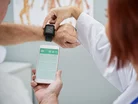Healthcare transformation, from telehealth to wearable tech

This year has seen a significant rise in telehealth – this being the distribution of health-related services and information via telecommunication technologies. Whilst not entirely new - this movement has been evolving for the past five or so years – the shift was significantly accelerated as COVID-19 shut down our regular healthcare systems.
The current funding for NHS digital health grants is up to half a million pounds which has further amplified the rise in digital healthcare. To help support social care the government has pledged £150m over the next three years in digital healthcare. Allowing long-distance patient and clinician contact, technology is transforming the way healthcare professionals treat and interact with patients – and it is a shift which is only going to continue to evolve at rapid pace as advancements in digihealth are set to take huge strides into 2023.
Telephone and video usage in healthcare
Using accredited online healthcare systems, individuals can get diagnoses, advice on whether a GP or hospital visit is required, advice on treatment options and access to programmes to address several health-related issues. At the start of 2021 NHS England recommended that at least 25% of all outpatient appointments should be by telephone or video for the foreseeable future. This approach also encourages individuals to become better educated about their health and promotes self-management and awareness for health conditions - making patients less reliant on needing to see a professional for every ailment.
Digihealth solutions allow patients to access an array of care services from across the healthcare sector from the comfort of their own homes - this extends to Chiropractic care amongst many others. Advancements in technology mean that the quality of the service provided via digital and telecommunication solutions is of the same high standards as if administered in a clinical setting, patients usually feel far more at ease as well.
The current sentiment towards digital healthcare, according to data from Statista shows that 68% agree that telehealth is more time effective and 61% feel that telehealth provides more accessible health care. However, there is currently 47% of those who feel an unwillingness to use telehealth service post-COVID-19.
There is huge support for digital transformation within the healthcare space. The movement not only allows the healthcare system to be even more accessible to a wider pool of patients requiring care, but can also support treatment plans and, through education and the trend towards wearable technology and use of mobile and online applications, is encouraging individuals to take greater responsibility for their own health and wellbeing. This is a welcome shift amongst the profession at a time when healthcare anxiety is on the increase.
Wearable tech and apps used in healthcare
The advancement and use of wearable tech and online apps is becoming a commonplace practice amongst healthcare professionals across the sector to support and educate individuals in managing their own health. Wearable technology is a great tool for healthcare practitioners as it tracks instantly accessible data 24/7 – including movement, level of activity, heart rate, instances of pain, biometric positions etc - all of which can be used to assist with treatment.
From a Chiropractic view, for many patients the link between anxiety, depression and stress and associated pain is often overlooked, yet extremely significant. As healthcare professionals, it is our responsibility to educate our patients to understand their fears and help them to manage their anxieties as part of the treatment for pain. The development of mobile and online apps makes treatments such as behavioural therapy and meditation accessible, enabling patients to better understand their conditions and learn how to manage their mental and physical health.
Exercise software technology
The use of exercise software is also on the rise and with the advancement in AI, these resources are becoming increasingly integrated within treatment and healthcare plans – a trend which is going to continue to develop into next year and beyond with the government investing £2bn into the digitisation of the NHS in a bid to ensure the long-term sustainability of the UK’s healthcare system.
Whilst these developments are going to continue to be integral in sustaining the healthcare system and provide effective tools for individuals to manage their own health and, for practitioners in providing effective treatment – we must not overlook the importance of face-to-face contact. The movement towards digitisation comes with many benefits but can also pose challenges. It is vital that these innovations strike an effective balance in ensuring face-to-face contact remains readily accessible and that those more vulnerable patients can still access the care they require.



